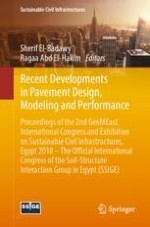2019 | Buch
Recent Developments in Pavement Design, Modeling and Performance
Proceedings of the 2nd GeoMEast International Congress and Exhibition on Sustainable Civil Infrastructures, Egypt 2018 – The Official International Congress of the Soil-Structure Interaction Group in Egypt (SSIGE)
herausgegeben von: Prof. Dr. Sherif El-Badawy, Ragaa Abd El-Hakim
Verlag: Springer International Publishing
Buchreihe : Sustainable Civil Infrastructures
